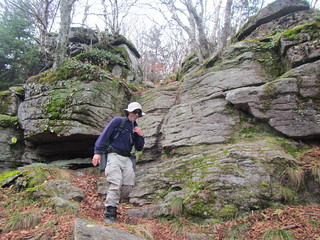 The hike up to the Red Hill fire tower is short - less than two miles each way - and although it is somewhat steep, it has little in the way of rocky climbs. I was surprised, then, to have it entirely to myself on what started out as a sunny Sunday.
The hike up to the Red Hill fire tower is short - less than two miles each way - and although it is somewhat steep, it has little in the way of rocky climbs. I was surprised, then, to have it entirely to myself on what started out as a sunny Sunday.It was colder than the previous day, with temperatures in the 30s. As I climbed out of the car, I was half in clouds and half in sun with what looked suspiciously like snowflakes falling around me. This mixed weather would continue for the rest of the hike.
Upon my arrival at the top, I was greeted with what was definitely snow. Looking at the first photo, you might not believe it. Even from the fire tower, one direction showed mostly blue skies, but the other showed what we see in the second photo.
 On summer weekends, a volunteer stays at the tower and opens the top to visitors. The volunteer season lasts through Columbus Day, so I had just missed it by one week. Nevertheless, you can still walk up the stairs and look around, which is where the second photo was taken. I didn't hang around long up there due to wind and cold. The top steps were even getting icy and slippery. I turned around and went back down the mountain. Of course, when I was about two-thirds of the way down, the cloud system blew out to bother another mountain, and the sun shone down through the trees. But that's part of hiking - you get the vagaries of weather.
On summer weekends, a volunteer stays at the tower and opens the top to visitors. The volunteer season lasts through Columbus Day, so I had just missed it by one week. Nevertheless, you can still walk up the stairs and look around, which is where the second photo was taken. I didn't hang around long up there due to wind and cold. The top steps were even getting icy and slippery. I turned around and went back down the mountain. Of course, when I was about two-thirds of the way down, the cloud system blew out to bother another mountain, and the sun shone down through the trees. But that's part of hiking - you get the vagaries of weather.



